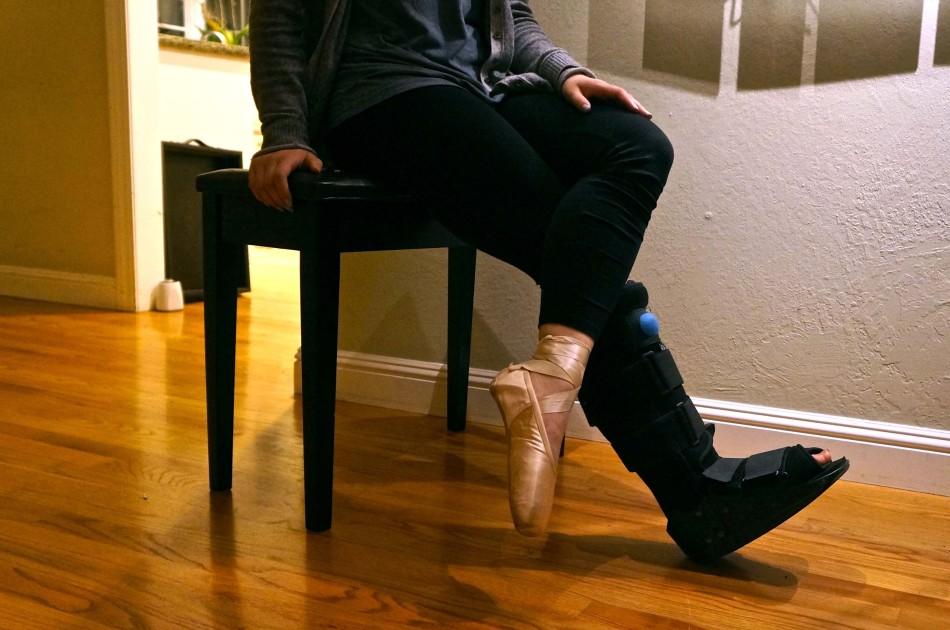Read it or Weep: From Pointe Shoes to Crutches
It’s been over a year since I took a wrong turn down the stairs, crashing into the ground. I tore a ligament in my ankle; I left the hospital in a boot and no possible way to dance.
I have been dancing for over ten years. Enough to say that I found myself with a passion lost.
The impact my injury has had on my life has been emotionally and physically straining. Ballet is not just a sport, or an after school activity that I participate in. It’s a lifestyle- the way that I walk, how I position my hips, the friends who share the same passions and struggles that I do. Although ballet was not my life, my heart sunk like a stone the moment the doctor uttered that one statement, “We may have to consider surgery.”
Often, ballet is scorned upon as just twirling in a tiara and tutus, but according to University of Washington’s 2000 study, ballet dancers suffer just as many severe injuries as other athletic groups. The injury rate for ballet dancers over an eight month period is 61 percent, comparable to rates found in other studies for collision sports like football and wrestling. With the average rest period as 10.5 days, the actual time lost ranges from one to 87 days.
I couldn’t bear to sit by and watch each class go by, watch every one of my friends improve as gravity pull my legs into the ground. I felt my legs lose flexibility, my muscles left unused. It was the only time my muscles ached to feel the burn of an exhausting class once again.
During the classes for young dancers I taught, I was immobile. Even my ten year old students improved each week. I sat from a cold, wooden chair; the jealousy festering inside my body like a tumor. My students would refer to me as “the broken Clara,” more often than my own name. I was the broken one, not beautiful or graceful to them. I was nothing to them, nothing more than an injury.
After a cortisone shot and months of physical therapy, I thought I was ready to dance again, only to be diagnosed again with another injury- tendonitis in both my achilles, and in the tendon I previously injured.
Achilles tendonitis is one of the most common injuries for dancers, an irritation of the achilles often caused by a repetitive relevés, or a raise from a flat foot to the a ball of the foot. The loss was unbearable. I had already auditioned and accepted into one of the most prestigious summer dance programs in the country, and now it was the time to hang my pointe shoes up on the door for a change of my safety boot and a pair of crutches.
Today, I grudgingly wait to wear crutches after my surgery. I will hold my head high and walk with the same grace as the ballet dancer I will always be: before, throughout, and after my procedure.
Kaity Gee’s (10) column “Read It or Weep” will appear on Alternate Saturdays, exclusively on Harker Aquila.

Kaity Gee (12) is the assistant Editor in Chief of Wingspan. Serving as a reporter for TALONWP freshman year, Kaity has written pieces for Winged Post...


















![“[Building nerf blasters] became this outlet of creativity for me that hasn't been matched by anything else. The process [of] making a build complete to your desire is such a painstakingly difficult process, but I've had to learn from [the skills needed from] soldering to proper painting. There's so many different options for everything, if you think about it, it exists. The best part is [that] if it doesn't exist, you can build it yourself," Ishaan Parate said.](https://harkeraquila.com/wp-content/uploads/2022/08/DSC_8149-900x604.jpg)




![“When I came into high school, I was ready to be a follower. But DECA was a game changer for me. It helped me overcome my fear of public speaking, and it's played such a major role in who I've become today. To be able to successfully lead a chapter of 150 students, an officer team and be one of the upperclassmen I once really admired is something I'm [really] proud of,” Anvitha Tummala ('21) said.](https://harkeraquila.com/wp-content/uploads/2021/07/Screen-Shot-2021-07-25-at-9.50.05-AM-900x594.png)







![“I think getting up in the morning and having a sense of purpose [is exciting]. I think without a certain amount of drive, life is kind of obsolete and mundane, and I think having that every single day is what makes each day unique and kind of makes life exciting,” Neymika Jain (12) said.](https://harkeraquila.com/wp-content/uploads/2017/06/Screen-Shot-2017-06-03-at-4.54.16-PM.png)








![“My slogan is ‘slow feet, don’t eat, and I’m hungry.’ You need to run fast to get where you are–you aren't going to get those championships if you aren't fast,” Angel Cervantes (12) said. “I want to do well in school on my tests and in track and win championships for my team. I live by that, [and] I can do that anywhere: in the classroom or on the field.”](https://harkeraquila.com/wp-content/uploads/2018/06/DSC5146-900x601.jpg)
![“[Volleyball has] taught me how to fall correctly, and another thing it taught is that you don’t have to be the best at something to be good at it. If you just hit the ball in a smart way, then it still scores points and you’re good at it. You could be a background player and still make a much bigger impact on the team than you would think,” Anya Gert (’20) said.](https://harkeraquila.com/wp-content/uploads/2020/06/AnnaGert_JinTuan_HoHPhotoEdited-600x900.jpeg)

![“I'm not nearly there yet, but [my confidence has] definitely been getting better since I was pretty shy and timid coming into Harker my freshman year. I know that there's a lot of people that are really confident in what they do, and I really admire them. Everyone's so driven and that has really pushed me to kind of try to find my own place in high school and be more confident,” Alyssa Huang (’20) said.](https://harkeraquila.com/wp-content/uploads/2020/06/AlyssaHuang_EmilyChen_HoHPhoto-900x749.jpeg)



